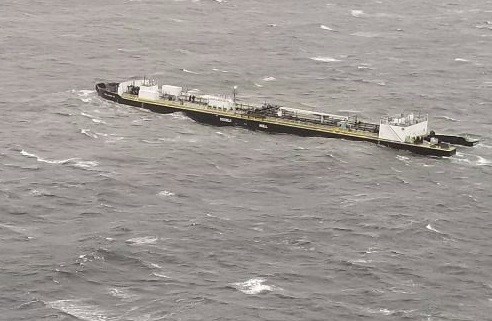Barges break loose. Rarely, but it does happen. Something goes sideways, usually during snotty weather, and next thing you know a tugboat is heading one way and the load it was towing or pushing is going somewhere else.
It happened Sunday up the central coast near Bella Bella, when a fuel barge came free of its tug. Two crew members managed to clamber aboard and drop anchor, but there were anxious hours before another tug, the Gulf Cajun, arrived to recapture the 128-metre-long barge and its four million litres of diesel and gasoline.
For people in Bella Bella, it was an unwelcome echo of October 2016 when the tug Nathan E. Stewart ran aground, leaking 110,000 litres of diesel.
Also in 2016, right here in Victoria, cleanup crews sucked tens of thousands of litres of oily water out of Esquimalt Harbour after a barge ran aground that May. That March, a storm blew two barges onto the beach as they were being towed past Dallas Road. One was retrieved within a day, but it took two weeks to refloat the second. Happily, the latter was loaded with nothing more hazardous than construction debris, so the environmental threat was relatively minor. Still, the fact that it took so long to deal with a problem here in the city, not off some remote stretch of coastline, shows how hard it can be to rectify marine mishaps.
Vancouver Islanders did once see how ugly it can get if a fuel barge spills its contents. Two days before Christmas 1988, the tanker barge Nestucca — after being loaded at the BP refinery at Cherry Point, Washington, and dragged past Victoria’s front porch — snapped its tow line near Grays Harbor, Washington. When the tug tried to retrieve the Nestucca, it punched a hole in the barge, resulting in the spill of 875,000 litres of Bunker C fuel oil.
On the U.S. side, tens of thousands of birds died and tar-like oil mucked the shore from northern Oregon to Dungeness Spit, right across the strait from Victoria. The goop also fouled Vancouver Island beaches from Sooke to Nootka Sound. Estimates of the number of dead Vancouver Island birds ranged from 3,100 to 56,000. The cleanup cost Canadian taxpayers $4.6 million. The spill was just 1/50th the size of the Exxon Valdez disaster that hit Alaska in 1989.
That was a long time ago, too long for many to remember. It’s a sign of how safe marine shipping really is. Ocean-going vessels transit Juan de Fuca Strait something like 10,000 times a year. Tankers of Alaska crude are visible from Victoria as they sail for northern Washington refineries. Bulk carriers laden with sand and gravel from northern Vancouver Island make the four-day journey to California. Coal carriers from Roberts Bank, container ships from Deltaport, nuclear submarines from the Kitsap naval base in Puget Sound — the strait is a two-lane highway that rarely sees anyone veer into the ditch.
The problem is that “rarely” doesn’t mean “never.” In 1991, the Japanese fish processor Tenyo Maru sank after colliding with a Chinese freighter at Swiftsure Bank. One crew member died and fuel oil spread to Oregon.
And there have been close calls. In November 2009, the bulk carrier Hebei Lion was blown onto a rocky reef near Mayne Island. Washington’s Ecology Department said a major spill there could have closed shipping altogether. A year later, a South Korean captain was jailed for drunk-driving a cargo ship near Port Angeles. In 2011, the captain of the USS Kentucky was disciplined after the nuclear-powered submarine almost hit a freighter in the strait.
Still, as British Columbians ponder the Kinder Morgan pipeline expansion, industry can argue that the sky has not actually fallen, that B.C. has never had an oil tanker spill. It only takes one, comes the reply.
The question becomes what level of risk is acceptable, and what can be done to mitigate it.
Almost exactly a year ago, Prime Minister Justin Trudeau announced the National Oceans Protection Plan, a five-year, $1.5-billion strategy the feds hoped would make B.C. coastal residents feel better about assuming all of the danger, and little of the benefit, of shipping Alberta oil by ocean tanker. Ottawa’s plan includes creating a marine safety system, restoring marine ecosystems, working with Indigenous communities and spending on oil-spill cleanup research. More radar sites for marine monitoring are promised, as are two rescue tugs for the West Coast.
Is that enough? Depends on if you see the oil barrel as half empty or half full.



